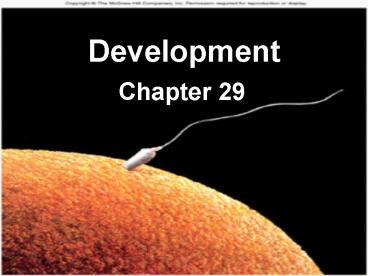Development PowerPoint PPT Presentation
1 / 14
Title: Development
1
Development
- Chapter 29
2
Human Development
- Fertilization and Pre-embryonic Stage
- Embryonic and Fetal Stages
- Neonate
3
Sperm Migration
- Few sperm get to egg
- destroyed by vaginal acid
- stuck in cervical mucus
- go wrong way
- Assisted by female physiology
- strands of cervical mucus
- uterine contractions
- chemical attraction
4
Capacitation
- Spermatozoa reach uterine tube in 10 min
- Capacitation
- takes 10 hours
- female fluids wash away inhibitory factors
- Sperm fertile for 48 hours
- Conception optimal if deposited 48 hrs before
ovulation to 14 hrs after
5
Fertilization
- Acrosome
- releases enzymes
- penetrates granulosa cells, zona pellucida
surrounding egg - membranes of gametes fuse and sperm enters
- Prevention of polyspermy
- fertilization membrane
6
Fertilization
- Secondary oocyte completes meiosis if fertilized
- sperm and egg pronuclei
- Chromosomes of 2 gametes mix
- Fertilized egg zygote
7
Pre-embryonic Stage - First 2 Weeks
- Cleavage
- mitotic divisions
- 30 hrs 2 cell stage (blastomeres)
- 72 hrs morula stage (solid ball of cells)
- Morula enters uterine cavity 6-7 days
- nourished by endometrial secretion (uterine milk)
- Zona pellucida disintegrates releases blastocyst
- outer cells (trophoblast) helps to form placenta
- inner cell mass (embryoblast) develops into embryo
8
Implantation of Blastocyst
- Attaches to uterine wall 6 days after ovulation
- Syncytiotrophoblast - multinucleate mass grows
roots and digests its way into endometrium - secretes human chorionic gonadotropin (HCG)
- becomes chorion
- Endometrium completely encloses embryo
9
Ectopic Pregnancy
- Blastocyst implants outside uterus
- 1 out of 300 pregnancies
- most cases in uterine tube (tubal pregnancy)
- tubal obstruction from previous pelvic
inflammations, repeated abortions or tubal
surgery - Tube ruptures by 12 weeks
- conceptus may reimplant in abdominopelvic cavity
- Where ever adequate blood supply
- usually requires an abortion
- 9 of abdominal pregnancies result in live birth
by cesarian section
10
Embryonic Stage or Weeks 2 to 9
- Begins when all 3 primary germ layers present
- Embryo receives nutrients from placenta
- Germ layers differentiate into organs and organ
systems - presence of organs marks the beginning of fetal
stage
11
Placentation
- Placenta forms 11 days to 12 weeks
- Chorionic villi
- extensions into endometrium
- digestion and growth of roots of tissue
- Placental sinus
- pools of maternal blood surround villi
- stimulates growth of chorionic villi
12
Organogenesis
- Formation of organs from primary germ layers
- 8 weeks, all organs present in 3 cm long fetus
- heart is beating and muscles contract
- Derivatives of ectoderm
- epidermis, nervous system, lens and cornea, inner
ear - Derivatives of mesoderm
- skeleton, muscle, cartilage, blood, lymphoid
tissue, gonads and ducts, kidneys and ureters - Derivatives of endoderm
- gut and respiratory epithelium and glands,
bladder and urethra
13
Premature Infants
- Infants born weighing under 5.5 lb.
- Infants born before 7 months suffer from
- respiratory distress syndrome
- insufficient surfactant ? alveolar collapse
- thermoregulatory problems
- digestive system not well developed low-fat
formula instead of breast milk - immature liver fails to synthesize plasma
proteins - edema, deficiency of clotting and jaundice from
bile
14
Nondisjunction and Aneuploidy
- Nondisjunction of sex chromosomes
- Triplo-X syndrome (XXX)
- infertile female with mild intellectual
impairment - Klinefelter syndrome (XXY)
- sterile males with average intelligence
(undeveloped testes) - Turner syndrome (XO)
- sterile, webbed neck, female with no 2nd sexual
features - Nondisjunction of autosomes often lethal
- Most survivable type is Down syndrome
(trisomy-21) - short stature, flat face with epicanthal folds on
eyes, enlarged tongue, stubby fingers and mental
retardation - Occurs in proportion to age of mother

